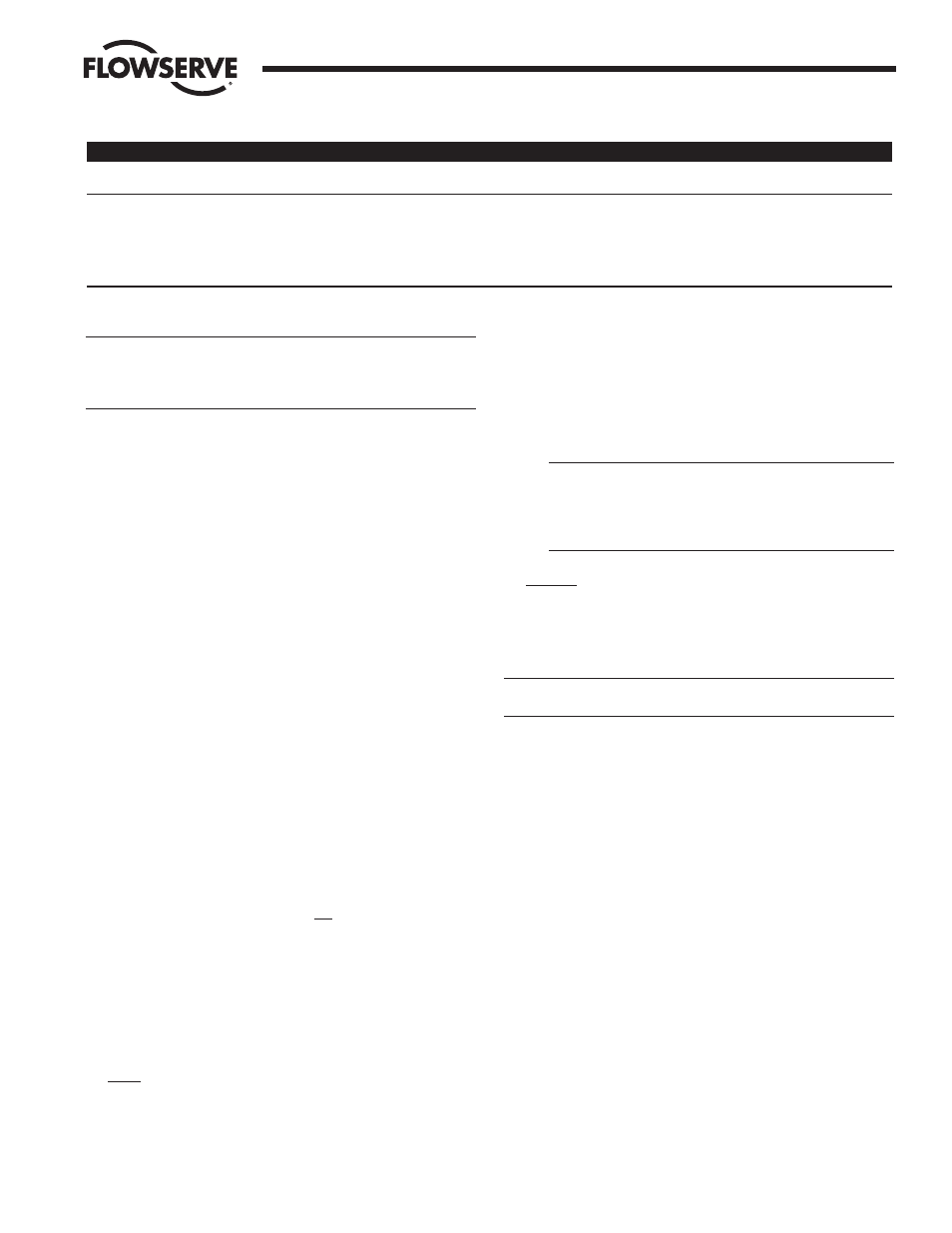Ii. operation, Iii. maintenance, Iv. rebuilding – Flowserve Factory Mutual Approved Oil or Gas Safety Shutoff Valve User Manual
Page 3: Worcester controls

WCAIM2054
Factory Mutual Approved Oil or Gas Safety Shutoff Valves
3
Flow Control Division
Worcester Controls
General Purpose Solenoid
Watertight And Hazardous Location Solenoid
Voltage
Holding
Inrush
Watts
Voltage
Holding
Inrush
Watts
Amps
Amps
Amps
Amps
Amps
Amps
24 VAC, 50/60 HZ
.80
1.20
11
24 VAC, 50/60 HZ
.71
1.13
11
120 VAC, 50/60 HZ
.15
.30
11
120 VAC, 50/60 HZ
.14
.23
10
240 VAC, 50/60 HZ
.08
.12
11
240 VAC, 50/60 HZ
.07
.11
10
12 VDC
.70
—
11
12 VDC
.17
—
10
24 VDC
.35
—
11
24 VDC
.41
—
10
CAUTION: Do not install 39S (spring-return) models with air
connection in end cap or with integral solenoid vertical, if water
spray or rainfall can occur in area. End cap or solenoid vent port
will allow water to accumulate in spring chambers.
NOTE: Sizes 10–35 Rev. R6 actuators may come with an ISO locating
ring, used for optimal ISO mounting.
The Series 39 pneumatic spring-return actuator is factory lubricated.
For optimum operation, filtered and lubricated air is recommended.
Requirements are as follows:
1. Pressure:
60 psig minimum to 120 psig maximum for all size actuators.
2. Air
Connection:
Z|v" NPT on the bottom of the solenoid block.
3. Electrical
Supply:
The solenoid coil/wattage and required amperage are as
indicated in the table above.
II. OPERATION
A. The safety shutoff valve is operated by energizing the solenoid to
open the valve. To close the valve, the solenoid is de-energized.
Loss of electrical power, or air pressure, or both, will result in the
actuator closing the valve.
Only the speed of the spring (closing) stroke is adjustable. This is
accomplished by tightening the set screw contained in the
exhaust nut (shipped separately in envelope) which mounts
directly to the end of the solenoid.
IMPORTANT: It is the
responsibility of the user to ensure that, when the spring stroke
speed is adjusted, closure time does not exceed five seconds.
B. The valve is a quarter-turn ball valve. Turning the valve 90°
counterclockwise opens the valve, and 90° clockwise closes the
valve. When used in accordance with the published pressure/
temperature chart, the valve will provide bubble-tight shutoff.
III. MAINTENANCE
A. Valve: For all valves, except as noted below, tighten retaining nut
one-sixth turn at a time if seepage is noted at stem.
For
Z|v"–2" 44, Z|v"–1Z|x" 59 and 2" 51/52 valves with self-locking
stem nut and four Belleville washers:
1. Tighten self-locking stem nut until Belleville washers are flat,
the nut will bottom.
2. Back
off
nut
Z|c turn.
CAUTIONS: The self-locking stem nut is difficult to tighten,
and must fully flatten Belleville washers before backing off.
Excessive tightening causes higher torque and shorter
seal life.
B. Actuator: Periodic checks are recommended to be certain all
fasteners remain tight.
IV. REBUILDING
a
WARNING: BALL VALVES CAN TRAP PRESSURIZED FLUIDS IN
BALL CAVITY WHEN CLOSED
If the valve has been used to control hazardous media, it must be
decontaminated before disassembly. It is recommended that the
following steps be taken for safe removal and disassembly:
• Relieve the line pressure. Operate the valve prior to attempting
removal from line.
• Place valve in half-open position and flush the line to remove any
hazardous material from valve.
• All persons involved in the removal and disassembly of the valve
should wear the proper protective clothing such as face shield,
gloves, apron, etc.
A. A standard repair kit can be ordered which contains all necessary
seats and seals to rebuild the valve. To order the repair kit (RK),
specify the seat and body seal material, the valve size and style,
and the R (revision) number of valve or the “P”, “T”, “C”, or
similar number, as found on the valve nameplate or on the
actuator bracket nameplate. If valve body is stainless steel, place
a “6” after valve size in repair kit ordering code.
The seats will be either virgin TFE (T) or reinforced TFE (R). The
body seals are standard virgin TFE (T) or Buna (B).
NOTE: These are the only materials approved by F.M. and the use
of any other materials may void the F.M. approval.
